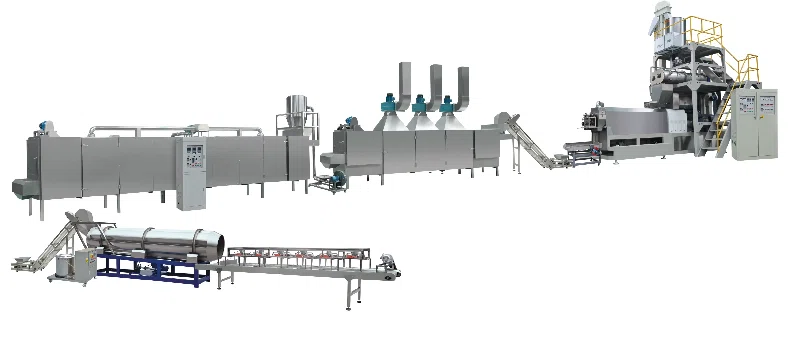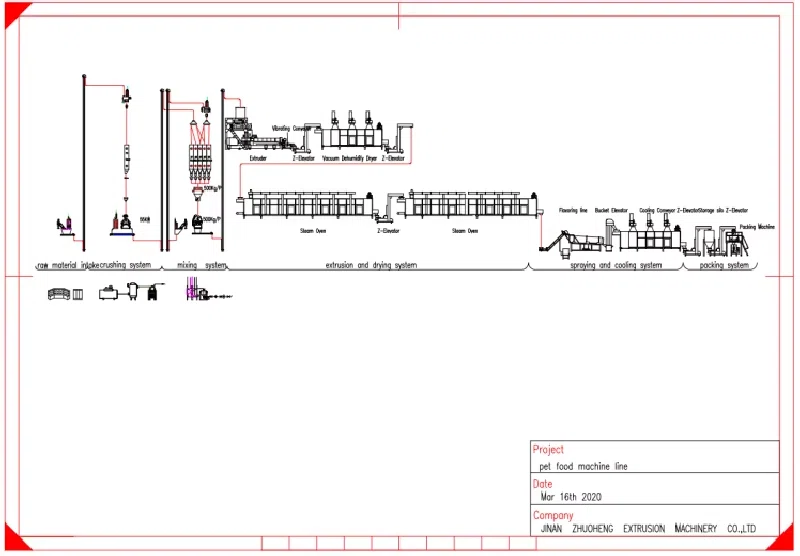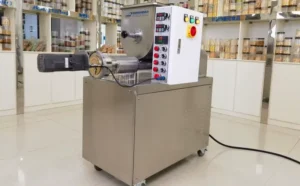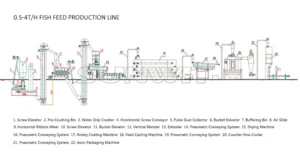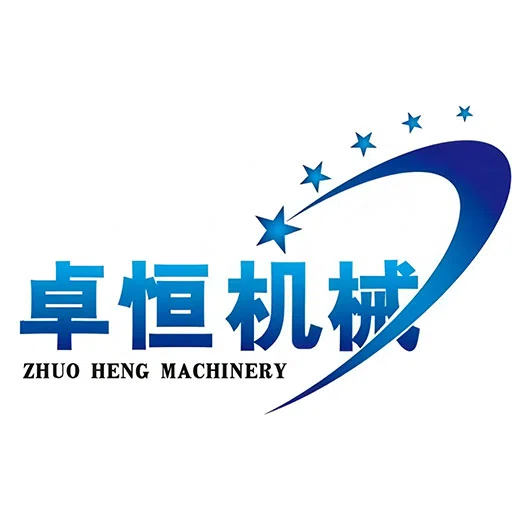The evolving aquaculture industry is constantly seeking new ways to enhance fish production while maintaining balanced nutrition and feed efficiency. With over 50% of production cost often attributed to feed, producers have a deep interest in optimizing both the nutritional quality and the physical properties of the feed. One question that often arises among fish farmers and feed manufacturers is: “Do you know if a fish feed extruder machine can make floating fish food pellets?”
In this article, we will explore the underlying science and practical considerations behind producing floating fish food pellets through extrusion. We will break down the processing differences, compare technology applications such as pellet milling and extrusion, and discuss how formulation and processing control directly affect the final product quality. Our goal is to provide you with a comprehensive guide that not only answers this question but also offers useful strategies and troubleshooting tips for your aquaculture feed production line.
Understanding Feed Production: Pellet Mill vs. Extrusion Process
Formulated fish feeds are widely recognized as one of the most cost-effective methods for achieving balanced nutrition in aquacultured fishes. Historically, traditional pellet mills have been used predominantly for feed production. These machines rely on compressing the raw material under specific pressure, moisture, and temperature conditions to form solid pellets. While pellet mills have proven effective for producing sinking feeds suitable for species like cod, shrimp, and river crab, they often fall short when it comes to fine-tuning physical feed attributes such as buoyancy.
On the other hand, the extrusion process offers a significant advantage. During extrusion, the process not only compresses the feed components but also “cooks” them, which helps in achieving a desired level of expansion. As the heated and gelatinized starch in the feed acts like a glue, it enhances the integrity of the pellets. This is essential for maintaining feed quality during storage, handling, and even when the pellets are cast into water.
The key differentiator between these two methods is the level of control they allow over feed buoyancy. In pellet mills, the inability to effectively lower the bulk density of raw materials often leads to sinking pellets. Conversely, extrusion facilitates manipulation of the feed’s density through careful control of temperature, moisture, screw profile, and screw speed, allowing producers to develop not just sinking pellets but also floating and slow-sinking types. Understanding these processing details is crucial for anyone seeking to maximize feed utilization efficiency.
The Science Behind Floating Feed Production
Floating feeds require a specific expansion process that is primarily influenced by the physical properties of starch. To explain briefly, when raw material containing starch is processed through an extruder, the high temperatures and pressures lead to starch gelatinization. In turn, this gelatinized starch expands when it exits the extruder, creating a porous structure that reduces the overall pellet density. Generally, a formula containing around 20% starch is ideal for producing floating feed pellets, whereas a formula with 10% starch is better suited for sinking feeds. This controlled expansion is what gives floating pellets the ability to float and remain intact in water.
Apart from starch content, factors such as protein, fiber, moisture, and the specific screw configuration play significant roles. Proper process control ensures that even with lower starch content, the pellets can achieve a desirable buoyancy. This science behind the process not only benefits fish nutrition but also enhances feed conversion ratios (FCR). A lower FCR means that fish can derive more nutritional value from every unit of feed, significantly reducing feed costs in the long run.
Extrusion Technology: How It Enhances Feed Quality
Modern extrusion technology offers feed manufacturers a range of options for optimizing feed quality. The extrusion process is inherently versatile and accommodates various types of feed by allowing for fine control of critical parameters. When compared to traditional pellet milling, extrusion has several notable advantages:
- Enhanced Pellets Integrity: The cooking process during extrusion gelatinizes starch, which acts as a natural binder. This strengthens the feed pellets and minimizes issues like dust creation and fines during storage and feeding.
- Nutrient Retention: Although extruders operate at higher temperatures (often above 90°C), careful process control can preserve key micronutrients essential for fish growth. In areas of nutrition where vitamins might degrade under heat, manufacturers can opt for more stable forms to maintain feed quality.
- Versatility in Feed Types: Through precise control of extrusion parameters—temperature, moisture level, screw speed, and configuration—producers can tailor feeds to be sinking, slow-sinking, or floating as required by different fish species.
- Cost-Efficiency in Feed Formulation: The extrusion process allows the use of lower starch levels without compromising the feed’s buoyancy. This flexibility means that higher quality protein ingredients can be integrated more cost-effectively.
As an example, one state-of-the-art food Extruder Machine is capable of processing both sinking and floating feeds with great precision. When discussing similar equipment, alternative terms such as extruder system or processing extruder can be used.
Comparing Pellet Mill and Extrusion: Which One Is Right for You?
The decision between employing a pellet mill versus an extrusion process largely depends on your target species and feed formulation requirements. For species such as tilapia, carp, and catfish that thrive on floating feeds, the extrusion process is an optimal solution. Traditional pellet mills fall short because their compression process does not permit fine-tuning of the buoyancy levels, resulting in denser, sinking pellets.
With extrusion, not only can you achieve the target buoyancy, but you also maintain other key attributes like uniformity in pellet size and overall feed integrity. This is particularly important for Fish Food Extruder systems that need to produce consistent and high-quality pellets across large production volumes.
Additionally, the extrusion process contributes to improved nutrient retention by reducing the formation of fines, which are the broken or pulverized parts of feed that inevitably occur during handling. This aspect is critical because fines not only represent a loss of usable feed but may also negatively impact water quality if they disperse during feeding operations.
The Role of Process Control in Achieving Desired Feed Characteristics
Process control is the heart of successful feed production. In extrusion, factors such as moisture, temperature, screw speed, and even the L:D ratio of the die significantly influence the quality and performance of the feed. The ability to control these variables precisely is what gives extrusion its edge over the pellet mill process.
For instance, the proper manipulation of these parameters can directly influence how well the starch gelatinizes and expands. This control determines not only the buoyancy but also the textural integrity of the pellet, ensuring that the feed remains intact during transportation and storage. Moreover, optimal process control minimizes nutrient degradation, safeguarding the essential vitamins and minerals necessary for fish growth.
In modern aquaculture systems, operators are increasingly using computerized monitoring systems to track and adjust these parameters in real time. The result is a finely tuned feed production line that maximizes both efficiency and feed quality.
Economic Implications of High-Quality Feed Production
Feed production represents one of the largest cost centers in aquaculture, and improvements in feed quality directly affect overall production economics. The extrusion process, although it might involve a higher initial capital outlay for equipment, often results in long-term savings. This is largely because extrusion allows for reduced ingredient costs through better formulation flexibility. With lower starch requirements and improved nutrient retention, the formulation cost is reduced while the overall feed performance is enhanced.
Extruder Maintenance Cost and Its Impact on Operational Efficiency
An often overlooked, yet critical, aspect of the extrusion process is the extruder maintenance cost. While modern extruders are designed for durability and high performance, regular maintenance is essential to ensure long-term operational efficiency and prevent unexpected downtime. Routine inspections and preventive maintenance help in detecting early signs of wear and tear, ensuring that components like screws, barrels, and dies remain in optimal condition.
Investing in a structured maintenance plan can save significant costs over time. Not only does it prolong the lifespan of the extruder, but it also ensures consistent feed quality by minimizing deviations in process parameters. Some strategies include scheduled cleaning, timely replacement of worn-out parts, and continuous monitoring of key performance metrics. Although extruder maintenance costs add to overall expenses, these costs are often outweighed by improved production reliability, lower feed conversion ratios (FCR), and higher overall profitability.
In summary, while initial investment and maintenance costs for extrusion equipment might be higher than traditional pellet mills, the long-term benefits—reduced raw material waste, enhanced feed performance, and lower operational disruptions—make it a sound investment for modern aquaculture facilities.
A Closer Look at Nutrient Retention and Feed Performance
When fish consume their feed, the efficiency of nutrient uptake is paramount. The extrusion process, thanks to its high heat and pressure treatment, cooks the macronutrients thoroughly. This results in more digestible feed components, allowing fish to extract maximum nutrition from every bite. In contrast, the pellet mill process does not achieve the same level of cooking, leading to less efficient nutrient absorption.
However, nutrient retention during extrusion is not automatic. The high temperatures that are beneficial for expanding the feed can also lead to the degradation of sensitive vitamins, particularly the fat-soluble vitamins (A, D, E, and K) and certain water-soluble vitamins. To mitigate this risk, modern extruder designs incorporate advanced process controls that minimize exposure to excessive shear and oxidation while optimizing the residence time of feed components.
Producers can also adjust feed formulations by including more robust forms of vitamins—such as ascorbic acid derivatives—that are better equipped to withstand the extrusion process. Such measures ensure that the final feed product retains its nutritional quality, ultimately contributing to improved fish growth and better overall feed performance.
Case Studies: Real-World Applications in Aquaculture
In various regions worldwide, aquaculture enterprises have successfully integrated advanced extrusion technology into their feed production lines. One such case study involved a mid-sized fish farm that transitioned from traditional pellet milling to an extrusion process. The results were remarkable: an improvement in feed uniformity, enhanced water stability, and a noticeable reduction in fines.
The farm observed that floating feed pellets produced via extrusion not only improved feeding efficiency for species like tilapia and carp but also improved overall fish health. The expanded pellet structure led to better nutrient retention and digestibility, resulting in a significant reduction in the feed conversion ratio (FCR). This translated into lower feed costs and ultimately higher profit margins.
Another successful application was found in a research facility that specialized in developing Fish Food Processing Machine and Food Fish Processing Equipment solutions. By optimizing extrusion parameters, the facility was able to tailor feed properties to meet specific dietary and behavioral needs of different fish species. This degree of customization was not achievable using conventional pellet mills.
Designing Your Feed Production Line for Optimal Results
For businesses in the aquaculture feed production sector, designing a processing line that integrates advanced extrusion technology is a crucial competitive advantage. An optimal feed production line not only incorporates a robust extruder system but also takes into account supporting equipment such as pre-conditioners, dryers, and coolers. Each element of the process contributes to the overall quality and efficiency of the feed.
When designing your production line, consider the following key factors:
- Equipment Compatibility: Ensure that all components—from the raw material handling systems to the final packaging units—are fully compatible with your extruder technology.
- Energy Efficiency: Modern extrusion systems are designed to optimize energy consumption during high-temperature processing. Select machines that offer precise control over processing parameters.
- Customization Capabilities: Opt for extrusion equipment that allows fine adjustments in screw configuration and die design. This flexibility is essential for producing feeds that meet specialized buoyancy and nutrient requirements.
- Ease of Maintenance: A well-designed feed processing line should facilitate easy maintenance and cleaning, thereby reducing downtime and ensuring consistent production quality.
With these considerations in mind, investing in a state-of-the-art Fish Food Extruder system can significantly enhance your operational efficiency and product quality. As you embark on upgrading or designing your feed production line, focus on technologies that offer robust process controls and customization options to stay ahead in the competitive aquaculture market.
Environmental and Sustainability Benefits
The benefits of advanced extrusion technology extend beyond operational efficiency and improved fish growth. In today’s environmentally conscious market, sustainability is a critical consideration. The extrusion process, when properly controlled, minimizes waste generation—especially the fines that typically result from pellet milling.
The reduction of fines translates into several environmental benefits, including:
- Lower levels of feed wastage during storage and handling
- Reduced water contamination during feeding operations
- Better utilization of raw materials, leading to more sustainable feed formulations
Moreover, extruded feeds are designed to be more digestible, which ultimately improves the feed conversion ratio (FCR). With improved feed efficiency, fish farms can reduce the volume of feed required, thereby lessening the environmental footprint associated with feed production and transportation.
Sustainability is a cornerstone of modern aquaculture, and investing in the right processing technology is a forward-thinking way to address both economic and environmental challenges. By embracing extrusion, producers not only improve fish health but also contribute positively to the ecosystem.
Future Trends in Feed Extrusion Technology
As technology advances at a rapid pace, the future of feed extrusion looks increasingly promising. Manufacturers and researchers are exploring innovations such as real-time process monitoring, enhanced screw designs, and even the integration of artificial intelligence to optimize production parameters continuously.
These advancements are expected to further enhance the precision and efficiency of feed production. The ability to adjust parameters on the fly can lead to even greater improvements in pellet integrity, nutrient retention, and feed performance. As a result, aquaculture systems that adopt these cutting-edge technologies will be better positioned to meet the challenges of tomorrow’s food production landscape.
In this dynamic market, staying updated with new trends is crucial. Many producers are now shifting towards automation and digital integration, enabling them to monitor key performance indicators in real time. This not only helps in maintaining consistent quality but also reduces the likelihood of process disruptions.
Implementing an Optimal Extrusion Solution in Your Facility
When planning the integration of an extrusion system into your aquaculture feed production facility, comprehensive planning is the key to success. An optimal solution should encompass equipment selection, process layout, and continuous quality control. Collaboration with technology providers who have a deep understanding of the extrusion process is an invaluable asset in this endeavor.
Leading manufacturers offer customized solutions that are specifically designed to cater to the unique requirements of different fish species. This customization extends to factors such as feed pellet size, water stability, and, notably, buoyancy. For instance, by adjusting processing parameters during extrusion, it is possible to produce floating pellets that maintain their integrity in water—a feature that is highly sought after in species like tilapia and carp.
Additionally, integrating quality management systems into your production line can further optimize your operations. Such systems leverage data analytics to provide insights into every stage of the production process, enabling timely adjustments that can prevent potential issues and ensure the consistent quality of the final product.
As you refine your production line, remember that the ultimate objective is to create a product that not only meets but exceeds the nutritional and functional requirements of aquacultured fish. With advanced extrusion technology at your disposal, this goal is well within reach.
Industry Best Practices and Expert Insights
Experts in aquaculture feed production emphasize the importance of aligning process technology with market demands. They advocate for a holistic approach that combines technical advancements, rigorous quality control, and sustainable practices.
Some best practices recommended by professionals in this field include:
- Regular Calibration: Ensure that all processing equipment is calibrated on a routine basis to maintain optimal performance.
- Quality Raw Materials: Source high-quality ingredients that are well-suited for the extrusion process. This helps in minimizing processing challenges and ensuring superior feed quality.
- Employee Training: Invest in ongoing training programs for your technical staff. A well-informed team is better equipped to troubleshoot issues and maintain production efficiency.
- Process Documentation: Keep detailed records of processing parameters and product outcomes. This data is invaluable for continuous improvement initiatives.
In addition, collaborating with suppliers of Fish Food Processing Machine and Food Fish Processing Equipment can provide further insights into optimizing your process. Such partnerships often lead to the adoption of new technologies and best practices that enhance both productivity and feed quality.
Key Takeaways and Final Thoughts
In summary, the question of whether a fish feed extruder machine can produce floating fish food pellets is answered with an enthusiastic “yes”—provided that process controls and formulations are meticulously managed. The extrusion process offers unparalleled flexibility in determining feed buoyancy, ensuring the final product meets the high standards required by the aquaculture industry.
While traditional pellet mills have their benefits, extrusion technology stands out in its capacity to improve nutrient retention, create specialized pellet types, and ultimately lower the feed conversion ratio. With the industry moving towards more sustainable and efficient production methods, adopting extrusion technology is a strategic move that promises long-term advantages.
Whether you’re a fish farmer aiming to maximize production or a feed manufacturer looking to improve your product range, understanding the nuances of the extrusion process is essential. Embracing technology, investing in quality raw materials, and continuously refining process controls are the cornerstones of success in modern aquaculture feed production.
For those ready to transform their operations, consider investing in a cutting-edge food Extruder Machine that combines precision, efficiency, and versatility. This investment can pave the way for a new era in feed production—one where quality meets innovation.
Q&A: Frequently Asked Questions
Q1: Can a fish feed extruder machine actually produce floating fish food pellets?
A1: Yes, with carefully controlled parameters such as moisture, temperature, and screw speed, an extrusion process can produce floating fish food pellets. The key is in optimizing starch gelatinization and the pellet structure during the extrusion process.
Q2: What makes extrusion preferable over pellet milling for certain fish species?
A2: Extrusion not only compresses the feed but also cooks it, leading to enhanced pellet integrity, better nutrient retention, and the ability to control buoyancy. This makes it particularly suitable for producing floating feeds that are ideal for species like tilapia, carp, and catfish.
Q3: How does the starch content influence feed buoyancy?
A3: The starch in the feed expands during the extrusion process, creating a porous structure that reduces the overall density of the pellet. Typically, around 20% starch in the formulation is optimal for floating feeds, while lower starch content may be used for sinking feeds.
Q4: What are the economic benefits of using extrusion technology in feed production?
A4: Although the initial capital investment may be higher, extrusion technology generally results in lower feed conversion ratios (FCR) due to enhanced digestibility and nutrient retention. This contributes to significant cost savings in the long run.
Q5: How do advanced process controls improve feed quality?
A5: Advanced process controls enable precise manipulation of temperature, moisture, and shear forces during extrusion. This leads to optimal starch gelatinization and pellet expansion, ensuring excellent feed integrity and nutritional performance.
Q6: How important is extruder maintenance cost when considering an investment in extrusion technology?
A6: Extruder maintenance cost is a crucial factor; regular maintenance minimizes downtime and ensures consistent production quality. By investing in a proper maintenance plan, producers can significantly reduce long-term operational costs and ensure that their extruder operates at peak efficiency.
By leveraging the strengths of modern extrusion technology and implementing robust process control measures, aquaculture feed production can reach new heights of efficiency, sustainability, and product excellence. We hope this article has provided you with valuable insights into how extrusion can transform your production line.
Whether you are just starting out or looking to upgrade your existing processing line, stay informed about industry best practices and technological advances to maintain your competitive edge in this rapidly evolving market.
Thank you for reading, and we look forward to your success in achieving superior feed performance and sustainable aquaculture.

